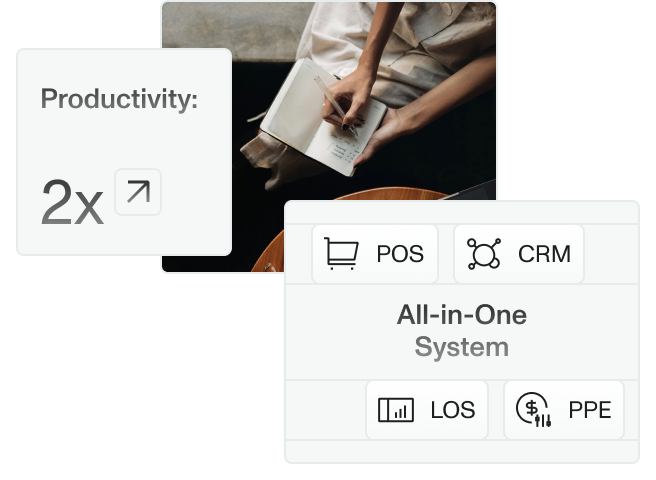A changing economy means loan officers will likely encounter mortgage applications supported by non-traditional income streams such as freelancing and consulting. A record 36% of employed Americans now consider themselves independent workers. Instead of W-2s and employer letters, these borrowers apply with 1099s, client invoices, and bank statements.
To thrive as a modern loan officer, learning how to assess these non-traditional income sources is critical.
Common Non-Traditional Income Sources
Non-traditional income describes any earnings that do not come from a regular, salaried job. Here are the most common types:
Freelance Income: Freelancers might earn income through writing, performing, driving, or any other type of independent contracting. Their financial documentation includes 1099-MISC or 1099-K tax forms.
Rental Properties: Borrowers with rental properties earn money through their residential or commercial tenants. If the property is newly purchased, the borrowers might bring tax returns demonstrating proven rental value or provide a signed lease showing projected value.
Investment Dividends: It’s common for older Americans to receive significant investment income, especially when retired. Such dividends include returns from stocks, bonds, and mutual funds.
Alimony and Child Support: Court-ordered payments like alimony and child support are typically accepted as income if the borrower can prove that the payments are regular and expected to continue for at least a few years.
Royalties: Artists with intellectual property may receive royalties as income. Royalties are usually irregular because compensation is paid over time based on success.
Evaluating Reliability and Stability
Before approving a mortgage loan based on non-traditional earnings, your team must determine if the income is likely to continue. Does the borrower have at least two years of tax returns showing steady or increasing income? Do they have multiple clients or tenants that provide a diverse revenue stream? These are some of the factors to consider when reviewing documentation.
You should also be on the lookout for red flags that may indicate the income is less reliable or stable. For instance, irregular earning patterns or inadequate documentation signal potential issues and may require further scrutiny. A high debt-to-income ratio is also a cause for concern.
Underwriting Mortgages with Non-Traditional Income
Before underwriting a mortgage loan based on non-traditional income, here’s what you should consider:
Assessing Risk
Regardless of its source, non-traditional income presents more risk because of its variability. A designer who has ten clients today might only have two next month. You’ll need to consider the nuances of the borrower’s financial situation and the impact of potential income fluctuations.
Income Calculation Methods
You can calculate non-traditional income in several ways. You might average their income over a certain period using bank statements, invoices, or tax returns. Given factors such as signed deals or a promising portfolio, you might also project the likelihood of continued income. Use calculations that make sense for the borrower’s situation.
Additional Documentation
Documentation requirements become more intense when the borrower doesn’t have a salary. Requesting extra proof of income, such as lease agreements and property appraisals for those with rental income and contracts or invoices for freelancers, is expected. The next step is to verify the income through bank statements and tax returns.
Debt-to-Income Ratio Considerations
The debt-to-income ratio determines whether the borrower can manage mortgage payments alongside existing debt. Calculating debt-to-income becomes more complex for applicants with variable income streams. You should look at income over a longer period.
Tips and Best Practices for Loan Officers
To stay relevant as a loan officer, you must keep a steady pulse on industry trends. Mortgage loans are highly regulated, and rules shift constantly. In addition, the mortgage market is subject to swings based on factors like inflation and interest rate changes. You should know what’s going on so you can prep your business.
It’s also wise to focus on building trust with borrowers. Take the time to figure out the best loan for their unique situations and provide personalized guidance. The effort you put into developing strong customer relationships will be repaid in glowing referrals and repeat business. You can utilize AI tools to make customer management easier.
AI also offers predictive analysis capabilities that are particularly advantageous in evaluating non-traditional income. For example, AI can evaluate bank statements and identify discrepancies in seconds.
Compliance and Regulatory Considerations
Complex mortgage rules and regulations govern how to process borrowers with non-traditional income. Remaining compliant is essential because lapses could trigger penalties or loss of customer trust.
Ensuring Compliance with Laws and Regulations
Your team should familiarize themselves with the laws and regulations that govern non-traditional income. A sophisticated loan origination system (LOS) that automatically updates to reflect new rules will help.
Adhering to Industry Standards
Adherence to industry standards, such as those set by Fannie Mae and Freddie Mac, keeps you consistent.
Mitigating Risks
Work with your team and implement robust risk management strategies that address the complexities of underwriting non-traditional income. One strategy might be utilizing AI to spot fraud. Another could be standardizing your required documentation.
The rise of gig work and freelancing has altered the workforce. Mortgage loan officers now routinely process applications citing non-traditional income streams. Continued success in the industry requires thoroughly understanding the different types of non-traditional income, implementing reliable evaluation processes, and staying aware of industry updates.
Check out Sonar’s mortgage solutions to streamline your non-traditional income evaluation process.







